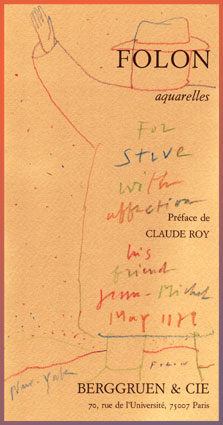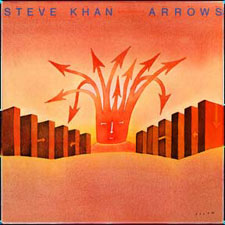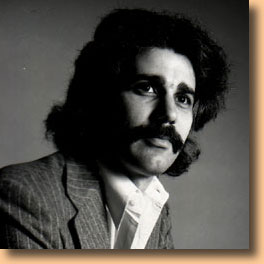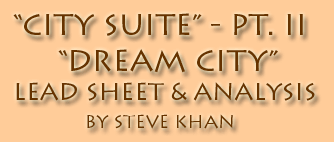Steve Khan's lead sheet:
"Dream City"(Khan)
Let us just pick up right where we left off last month. Remember, we had just completed examining "City Suite" Part I: "City Monsters" which appeared on my 1979 LP titled, "ARROWS." Both pieces in this Suite were inspired by the first 10 years of my life in New York City, which had become the city of my dreams, in short a "Dream City." Like Part I, this title was also lifted from a painting by Jean-Michel Folon which I had viewed at an exhibit around that time. Having grown-up in Los Angeles during the '50s and '60s, all the various cultures had not truly melded together there and the lives of all these varied human beings rarely intersected. However, the moment one sets foot in New York, you sense that everyone is thrown into this great 'melting pot' together and must learn to be together, work together, live together, in a higher form than mere coexistence. The better we can all be at doing this, the more it is possible to turn any city into a "Dream City." At least we can hope so. Having grown-up in Los Angeles during the '50s and '60s, all the various cultures had not truly melded together there and the lives of all these varied human beings rarely intersected. However, the moment one sets foot in New York, you sense that everyone is thrown into this great 'melting pot' together and must learn to be together, work together, live together, in a higher form than mere coexistence. The better we can all be at doing this, the more it is possible to turn any city into a "Dream City." At least we can hope so.
The two parts of the "City Suite" were actually recorded separately at Mediasound Studios on May 8th, 1979, but it was planned that way. As this was all prior to the "Digital Age" of recording, some planning was required to give us the best possible edit point for cutting the tape. What we as letter [D] of "City Monsters" ended on the sustained Bb/C chord was that Steve Gadd was to play a single bass drum hit on beat 1 of the imaginary next bar. That single beat would become our edit point later. It was always planned that Part II of the Suite, "Dream City" would begin with Don Grolnick playing my 'accidental' 2:3 montuno on acoustic piano with Steve Gadd soloing over it. Percussionist "Crusher" Bennett offered to anchor everything with a campana pattern. Though my memory of this recording is foggy at best, it seems to me that we did two takes of this piece but chose the 2nd take. However, it is my recollection that Steve Gadd's solo on the 1st take was really amazing. I am certain of one thing, had digital recording and editing been possible then, I am certain that we could have easily grafted on that solo to the better over-all performance we ended-up choosing. Unfortunately, I don't even have a rough mix copy of that other take here, and it was never really finished. So, it remains incomplete at best.
In some ways, the marriage of Latin music with Richard Tee and Stuff seems like forcing the proverbial 'square peg' in a 'round hole' but, if one accepts the notion that both form of music are deeply rooted in dancing as well as for listening, then it is not that great of a stretch to envision them as existing within the same tune. For me, as it always is, it was great fun to actually sit and transcribe, though loosely, what the great electric bassist, Will Lee improvised when we hit [A]. Though I suppose that Will and Steve Gadd were approaching this section with the 'swing' and light-heartedness that would exist in any Stuff groove, but, it is not all that far from certain 'Disco' feels of that time. So, Will's quasi-walking bass line is rich with his spirit and creativity. He remains as one of the most musical people with whom I've ever had the privilege of working. Like all the other players on this recording, they make anything sound and feel better than one could have imagined.
As a part of my tribute to New York City, for most of us, our "Dream City," letter [A] is a heartfelt salute to the great Richard Tee and his Fender Rhodes style. Don Grolnick seemed to be able to make Richard's stylings his own while adding in a very particular kind of harmonic sophistication. Like Richard Tee, Don was just the most superb accompanist and his playing always gave you the most wonderful bed of harmony over which to play. He was always listening and operating somewhere between being in the groove, in the moment with the soloist, but also being part of rhythm section unit with Will, Steve, and Jeff. Melodically, the lines are all derived from the R&B nature of employing the G minor pentatonic[G, Bb, C, D, F] over all four chords: Bbmaj7(9)-C7(9)-Ebmaj7(9)-Ab7(9b5). However, I can also hear elements of the Bb blues scale[Bb, Db, Eb, E, F, Ab] over the Ab7(9b5) chord. This is pretty common over changes like this. When the solo section appears at [C] over these same changes, the approaches broadens and both Jazz and Jazz-Fusion elements come into play. And, for better or worse, a lot more notes. But, that's what we were playing like back then.
Without any question, I would have to say that my absolute favorite section during any portion of the "City Suite" has to be letter [B] of "Dream City." Considering the year of this recording, it seems obvious that the influence of Chick Corea's writing from the Joe Farrell, Airto & Flora period of "Return to Forever" and, from his "MY SPANISH HEART" LP is felt here. This type of guitar sound sits well as the top voice of all those 6ths which are, of course, played beautifully and romantically by Don Grolnick. It is also worth paying close attention to some of Steve Gadd's tremendous drum fills. In the analysis of "City Monsters", I mentioned my conversation about Latin rhythms with saxophonist, Rafael Greco and, as part of that talk, we spoke about Steve Gadd's rhythmic approach to this particular section. Of course, I was anticipating that he was going to tell me that Steve was playing some kind of specific Latin rhythm for which I might not have known the precise name. Wrong, again!!! It turns out, in Rafa's humble estimation that, Steve is playing another fusion of Brazilian rhythms, but this time it seems to approximate a "baião" feel more than anything else. "Crusher" Bennett is alluding to the Latin "caballo" rhythm on his congas. In English, we might say that his tumbao has a 'gallop' to it, like a horse. You dig? And so, my education just continues.
Where improvising theory is concerned it is worth taking a look at what I played over both [I4] sections. Once again, I put to use the G minor pentatonic[G, Bb, C, D, F] over the whole progression: Bb/F - D7/F# - Gm7 - Abmaj7(9). I used the same harmonic approach when we D.S. back to [I4] on Pg. 2. It becomes a bit more 'notey' but the idea is the same. Again, this is a most effective way to keep elements of 'the blues' in play even though the chord changes might not remind anyone of that genre or even good, old-fashioned R&B.
To continue with the theoretical approach to letter [C], the guitar solo section, which appears on Pg. 4, I am going to address each of the four chords individually. The chord changes to the solo section obviously mirror those which appear in [A]. If there is one constant, which appears at varying times over each of the chord changes, it is that I use the G minor pentatonic[G, Bb, C, D, F] to keep the thread of R&B and Jazz-Rock Fusion running through the entire solo. This means, more than just those five pitches, there are all the inflections of bent notes and other mannerisms which reflect that melding of genres. I think that, what makes this one pentatonic so effective over all the changes is the emphasis on and recurrence of the note Bb in all areas. Over the Bbmaj7 chord, when something resembling a true scale or mode appears, I am sticking close to Bb major, but it seems that I avoid playing Eb's. Over the C7(9) chord, there is, initially, a reference made to the C blues scale[C, Eb-E, F, Gb, G, Bb]. When a mode is indicated, I applied the G Dorian[G, A, Bb, C, D, E, F]. I repeat, the use of the G minor pentatonic is a constant! When the Ebmaj7(9) chord arrives, I tend to indicate Eb Lydian[Eb, F, G, A, Bb, C, D], but you don't really hear the note 'A'(#4) employed until later in the solo. Don't forget, the G minor pentatonic is at work over this chord too! Finally, there is the Ab7(9b5) chord, and the first time it arrives, it sounds to me, more than anything else, I was using Eb Dorian over it. However, later, I use what I would consider to be more 'correct' by playing Eb melodic minor[Eb, F, Gb, Ab, Bb, C, D]. This is the better choice because D-natural is really 'in the chord' and Db is not. However, if you brush over that pitch quickly, it goes by unnoticed. When I played some rock-oriented phrases, I could also hear the usage of the Ab dominant 7th pentatonic[Ab, Bb, C, Eb, Gb]. In listening to the solo, I was struck by how much I used the upper, upper registers of the guitar. Hitting my high 'D' a couple of time with bent notes. Now, it feels like I haven't visited that stratosphere in years! Finally, there is the Ab7(9b5) chord, and the first time it arrives, it sounds to me, more than anything else, I was using Eb Dorian over it. However, later, I use what I would consider to be more 'correct' by playing Eb melodic minor[Eb, F, Gb, Ab, Bb, C, D]. This is the better choice because D-natural is really 'in the chord' and Db is not. However, if you brush over that pitch quickly, it goes by unnoticed. When I played some rock-oriented phrases, I could also hear the usage of the Ab dominant 7th pentatonic[Ab, Bb, C, Eb, Gb]. In listening to the solo, I was struck by how much I used the upper, upper registers of the guitar. Hitting my high 'D' a couple of time with bent notes. Now, it feels like I haven't visited that stratosphere in years!
Now, with the presentation of both Part I & II of the "City Suite", it means that we have presented all the original music from "ARROWS" at Korner 2. Since the launching of the website in 1998, the constant flow of e-mails via the CONTACT STEVE page has been a great source of amazement for me. Surprising, because so many of you hold the three Columbia recordings in such a special place in your memories. I just want to thank you all for the ongoing support and encouragement. I appreciate it so very much even though, thank goodness, my playing and writing have evolved from those bygone days. None of this would have been possible without the remarkable musicianship and contributions of all the players, and engineers Elliot Scheiner and Doug Epstein. I remain forever grateful to all of you!!!
[Jean-Michel Folon's personal inscription to Steve from the souvenir booklet
Galerie Berggruen Exhibition in Paris from 1979
Photo Portrait of Steve by Jim Hougton, taken in 1979]
|

